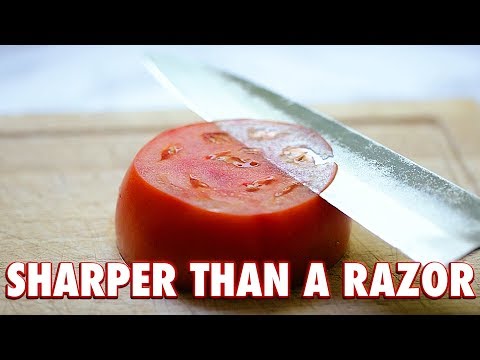
a09d13898e399747fb217f85361f94c8
Sharpening knives is an essential skill for any home cook. It is important to keep your knives sharp in order to ensure that they are safe to use and that they will perform their best. While there are many ways to sharpen a knife, using a stone is one of the most effective and traditional methods. In this guide, we will discuss the basics of sharpening knives with stones, including the types of stones, the sharpening process, and tips for getting the best results.
How to sharpen a knife with a stone for beginners step by step
Sharpening a knife with a stone is a skill that can be learned with practice. It is important to understand the basics of sharpening a knife before attempting to do so. This article will provide a step-by-step guide for beginners on how to sharpen a knife with a stone.
Step 1: Gather the Necessary Materials
The first step in sharpening a knife with a stone is to gather the necessary materials. You will need a sharpening stone, a honing oil, a cloth, and a knife. The sharpening stone should be a medium-grit stone, such as a 1000-grit stone. The honing oil will help to lubricate the stone and prevent it from becoming clogged with metal particles. The cloth will be used to wipe away any excess oil or metal particles.
Step 2: Prepare the Stone
Once you have gathered the necessary materials, you will need to prepare the stone. Start by soaking the stone in water for 10-15 minutes. This will help to soften the stone and make it easier to use. Once the stone has been soaked, use the cloth to wipe away any excess water.
Step 3: Apply the Honing Oil
Once the stone has been prepared, you will need to apply the honing oil. Use the cloth to spread a thin layer of oil over the entire surface of the stone. This will help to lubricate the stone and prevent it from becoming clogged with metal particles.
Step 4: Begin Sharpening
Now that the stone is prepared, you can begin sharpening the knife. Start by placing the knife on the stone at a 20-degree angle. Then, using a back-and-forth motion, move the knife across the stone. Make sure to keep the angle consistent throughout the sharpening process. After a few passes, you should begin to see a burr forming on the edge of the blade.
Step 5: Flip the Knife and Repeat
Once you have finished sharpening one side of the blade, you will need to flip the knife over and repeat the process on the other side. Make sure to keep the angle consistent and use the same back-and-forth motion. After a few passes, you should begin to see a burr forming on the edge of the blade.
Step 6: Remove the Burr
Once you have finished sharpening both sides of the blade, you will need to remove the burr. To do this, use a finer-grit stone, such as a 3000-grit stone. Start by placing the knife on the stone at a 10-degree angle. Then, using a back-and-forth motion, move the knife across the stone. Make sure to keep the angle consistent throughout the sharpening process. After a few passes, the burr should be removed.
Step 7: Clean and Store the Knife
Once you have finished sharpening the knife, you will need to clean and store it. Use the cloth to wipe away any excess oil or metal particles. Then, store the knife in a safe place, such as a knife block or a drawer.
Conclusion
Sharpening a knife with a stone is a skill that can be learned with practice. By following the steps outlined in this article, you can learn how to sharpen a knife with a stone for beginners. With practice, you will be able to sharpen your knives with ease.
What grit guide for knife sharpening
Sharpening a knife is an important skill to have, and it can be done with a variety of tools. One of the most popular tools for sharpening knives is a grit guide. A grit guide is a tool that helps you determine the best grit for sharpening your knife. It is a simple tool that can help you get the best results when sharpening your knife.
A grit guide is a simple tool that consists of a series of numbered slots. Each slot corresponds to a different grit size. The higher the number, the finer the grit. The lower the number, the coarser the grit. The grit guide helps you determine the best grit for sharpening your knife. It is important to use the right grit for the job, as using the wrong grit can damage the blade.
When using a grit guide, it is important to start with the coarsest grit and work your way up to the finest. This will ensure that you get the best results.
You should also use a honing stone or sharpening stone to finish the job. This will help to ensure that your knife is sharp and ready to use.
Using a grit guide is a great way to ensure that your knife is sharpened correctly. It is important to use the right grit for the job, as using the wrong grit can damage the blade. It is also important to use a honing stone or sharpening stone to finish the job. With the right tools and a little practice, you can easily sharpen your knife with a grit guide.
How do you sharpen a knife with a guide
Sharpening a knife is an important part of knife maintenance. It is important to keep your knives sharp to ensure they are safe and effective to use. A guide is a great tool to help you sharpen your knives quickly and easily. Here is a step-by-step guide on how to sharpen a knife with a guide.
Step 1: Gather the Necessary Tools
Before you begin sharpening your knife, you will need to gather the necessary tools. You will need a sharpening guide, a sharpening stone, and a honing steel. You may also want to have a cloth or towel handy to wipe off the blade after sharpening.
Step 2: Secure the Knife in the Guide
Once you have all the necessary tools, you will need to secure the knife in the guide. Place the blade of the knife in the guide and make sure it is secure. The guide should be adjusted so that the blade is at the correct angle for sharpening.
Step 3: Sharpen the Knife
Once the knife is secure in the guide, you can begin sharpening the knife. Start by running the blade along the sharpening stone. Make sure to keep the blade at the same angle as the guide. Move the blade back and forth along the stone until it is sharp.
Step 4: Hone the Knife
Once the blade is sharp, you will need to hone it. To do this, run the blade along the honing steel. This will help to remove any burrs or imperfections on the blade. Make sure to keep the blade at the same angle as the guide.
Step 5: Clean the Knife
Once you have finished sharpening and honing the knife, you will need to clean it. Use a cloth or towel to wipe off any excess oil or debris from the blade. Make sure to clean the blade thoroughly before storing it.
Conclusion
Sharpening a knife with a guide is a quick and easy way to keep your knives sharp. By following these steps, you can ensure that your knives are safe and effective to use. With a little practice, you can become an expert at sharpening knives with a guide.
Are sharpening stones the best way to sharpen a knife
Sharpening a knife is an important part of kitchen maintenance. A sharp knife is safer to use and will make your cooking tasks easier. There are many ways to sharpen a knife, but sharpening stones are often considered the best option.
Sharpening stones are made from a variety of materials, including diamond, ceramic, and natural stones. They come in a range of sizes and shapes, and can be used to sharpen both straight and serrated blades. The stones are used with water or oil, and the user must move the blade in a specific pattern to sharpen it.
Sharpening stones are often preferred over other methods because they provide a more consistent result. Electric sharpeners, for example, can be difficult to use and can damage the blade if used incorrectly. Additionally, sharpening stones can be used to sharpen a variety of knives, from kitchen knives to pocket knives.
Sharpening stones are also relatively inexpensive and easy to use. They require minimal maintenance and can be used for years. Additionally, they can be used to sharpen other tools, such as scissors and chisels.
However, sharpening stones are not the only option. Electric sharpeners, honing steels, and pull-through sharpeners are all viable alternatives. Each has its own advantages and disadvantages, so it is important to consider your needs before making a decision.
In conclusion, sharpening stones are often considered the best way to sharpen a knife. They are relatively inexpensive, easy to use, and provide a consistent result. However, there are other options available, so it is important to consider your needs before making a decision.
We hope this guide has been helpful in teaching you how to sharpen knives with stones. With practice and patience, you’ll be able to keep your knives sharp and in top condition.
Thank you for reading and goodbye!














